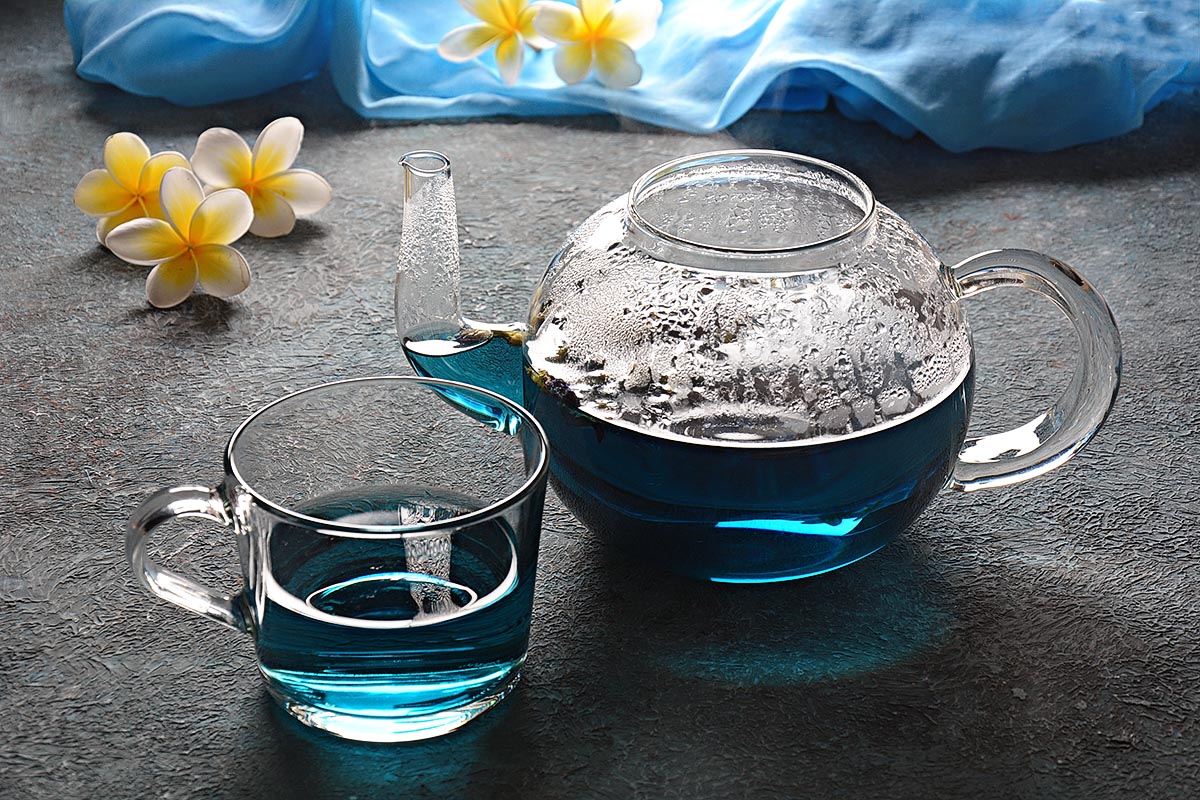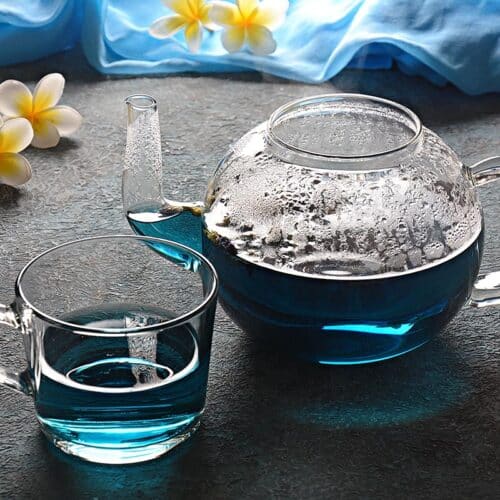The butterfly Pea is an herb native to Southeast Asia and known for its vibrant blue hue. It has been used for centuries in Southeast Asian cuisine, teas, and even dyes. But what does Butterfly Pea taste like?
With its sweet floral notes, complex herbal flavor profile, and subtle earthy undertones, it’s a flavor that is unique and hard to miss! In this article, we will explore the taste of Butterfly Pea and some interesting ways to use it.

The butterfly pea is a perennial climbing shrub native to tropical and subtropical regions of Asia, Africa, and the Pacific islands. This flowering plant has a scientific name, “Clitoria ternatea“.
The plant has bright blue flowers earning it nicknames like “blue pea” and “Asia pigeonwings.” The flowers are used as an herbal tea, food coloring, and medicinal herb in many cultures.
It has been used in India for centuries, typically combined with turmeric and other spices, to make Ayurvedic dishes more vibrant.
In Thailand it is known as “blue tea” while in Vietnam it is known as “Vietnam tea”.
Butterfly pea grows abundant across Asia, playing roles in culture and cuisine. In India, locals consider the butterfly pea a holy flower. And because of its claimed health benefits, it’s often used in Ayurvedic medicine. In the kitchen, butterfly pea is a natural food coloring. It’s perfect for dyeing rice, desserts, and beverages.
But if there’s one thing butterfly pea is best known for: it’s brewing tisane or herbal tea. Butterfly pea flower tea is widely popular in Southeast Asia and can be found served both hot and cold.
Butterfly pea tea is an herbal tea made from blue pea flowers. Like most herbal teas, butterfly pea tea has a light floral aroma. But what makes it stand out is its deep blue hue.
Due to its vibrant color, many Thai hotels serve cold blue tea as refreshments. And since butterfly pea tea is naturally caffeine free, you can drink it after dinner.
Butterfly pea tea is available in whole, dried, and powdered forms. If you’re after flavor, whole and dried flowers taste best. Powdered butterfly pea is better for natural dyes.
Butterfly pea flowers grow wild but are uncommon outside Asia. If you’re from the United States, chances are you’re not going to find this tea in local stores. Recently, the butterfly pea flower has been gaining popularity in the West due to its health benefits and vivid color. It can be purchased online or at specialty health food stores.
The tea owes its unique color-changing ability to anthocyanin. Not only does it give the flower its blue color, but it also acts as a base compound. Adding another ingredient to the tea affects the pH level, resulting in a different color.
For example, adding an acidic ingredient like lemon or lime juice changes the blue tea to purple. And if you like red drinks, hibiscus leaves should do the trick.
Butterfly pea tea has a delicate flavor of earthy and woody undertones. And contrary to its bright candy-like color, it doesn’t taste sweet at all. People who tried the famous tea describe it as an unsweetened yet refined version of green tea.
Butterfly pea can be enjoyed both hot or cold depending on your preference. It is often used in tea blends or as a natural food coloring agent due to its deep blue hue when brewed.
It’s also becoming increasingly popular in cocktails as well! So if you’re looking for something unique, try adding butterfly pea to your repertoire.
For herbal teas like butterfly pea, an infusion is the best way to extract its flavor. The key is steeping and not boiling since the latter risks draining most of the taste.
Here’s a quick guide on how to make your cup of butterfly pea tea:
You’ll need:
Directions:
Tips:
Green tea and butterfly pea tea taste similar. The blue tea’s light flavor makes room for delicious mixes. You can add your favorite green tea mixes, and they’d likely taste the same. For your next brew, here are our top suggestions:
Lemon is a favorite when it comes to butterfly pea tea. Not only does it change the tea’s color, but it also adds a contrasting flavor. Lemon has a tangy taste and a pleasant citrusy aroma. Even a slight squeeze is enough to bring out the blue pea’s grassy flavor. And if you want to switch things up, you can add the tea to lemonade. It won’t affect the drink flavor-wise, but you’ll have cool purple lemonade.
Honey is a natural sweetener for tea, especially for butterfly pea tea. This blue tea is surprisingly earthy without a hint of sweetness. Adding honey can level some of the earthiness away. For zesty drinks, try pairing butterfly pea tea with honey and lemon.
Mint, on its own, has a menthol-like effect on the mouth. So when paired with butterfly pea tea, it blends well with the earthy and grassy tones. Adding the mint as whole leaves while the tea steeps also brings out a more potent flavor. Mixing peppermint tea and butterfly pea tea can mimic the same taste.
If you’re looking for a warm drink, why not mix ginger with butterfly pea tea? Ginger has a peppery, grassy, almost spicy flavor without any bitterness. And if you add it to blue tea, ginger enhances the earthiness and leaves a warm feeling on the throat. Combined with honey, ginger, and blue tea is the ultimate bedtime drink.
Cinnamon is another warm spice that you can use. It has a spicy flavor like ginger but with an added distinct sweetness. Although usually paired with hot cocoas and coffee, you can sprinkle it over blue tea. Another way is to boil a cinnamon stick and use the water to steep the butterfly pea flowers. This process guarantees a stronger cinnamon flavor for your blue tea.
When it comes to food, butterfly pea tea doesn’t add much in terms of flavor. But it does make for a colorful dish! From eggs to cocktails, you can add this blue tea to almost anything. Let’s take a look at five creative ways to bring more color to your food:
Unsurprisingly, the most popular use of blue tea is in cocktails. Bartenders serve the tea in “mood ring cocktails,” showing off its color-changing effect. Aside from adding lime, tonic water can also prompt a rosy pink hue from blue tea. You’ll often see this drink paired with sparkling wine, mimosas, or carbonated water.
Nasi kerabu is a Malaysian dish typically served with blue rice. Locals cook the flowers and rice together, resulting in a bright color. Though it doesn’t add much flavor, it does boost visual flair. Nasi kerabu pairs great with fried chicken, crackers, and pickled vegetables.
Nam dok anchan is a refreshment specifically made from butterfly pea flowers. It’s a typical Thai drink which is basically purple iced lemonade. For extra theatrics, try freezing the blue tea into ice cubes instead. Once guests arrive, pour the ice cubes into a lemonade punch for a little show!
Unlike the previous dishes, unicorn noodles are a new invention. All you need to do is boil glass noodles in butterfly pea flowers. You’ll get blue-to-purplish noodles, which will surely brighten up a plate. At this point, complete the rainbow look and serve with an assortment of colorful side dishes.
Dr. Seuss can pack his green eggs and ham because purple eggs are in! Pump up your mornings by boiling eggs with blue tea. The egg whites absorb the color as they cook, creating deep blue to purplish eggs. Purple eggs are delicious, and you won’t have to look at boring eggs ever again.
Want a latte without the coffee? It’s possible – mix blue tea with steamed milk. It has everything you need from a latte; the sweet, creamy taste with no caffeine packed in a pretty blue package. Blue lattes are excellent decaf drinks that you can enjoy any time of the day.
No, but it can be. Like all herbal teas, the butterfly pea flower taste goes bitter when you oversteep. Oversteeping means letting tea sit in the water too long. The flowers release more tannins, giving off a bitter taste.
No, it’s caffeine free! So you can drink butterfly pea tea before bed.
In the United States, you can buy butterfly pea tea through online tea stores. It’s more abundant in Asia, where you can buy the flowers from local markets.
Butterfly pea flower tea is an Asian herbal tea famous for its color and flavor. With a small help from a lemon wedge, the drink changes color in seconds. But when it comes to taste, it remains consistent.
So, what does butterfly pea tea taste like? This blue tea has a mild flavor, boasting earthy and woody notes. But the tea’s subtlety is its best trait, making it an excellent pair for other flavors. Next time you brew a cup, add lemon, ginger, or a dash of cinnamon.






